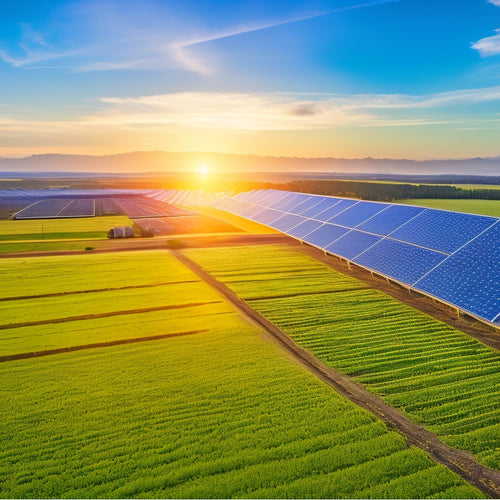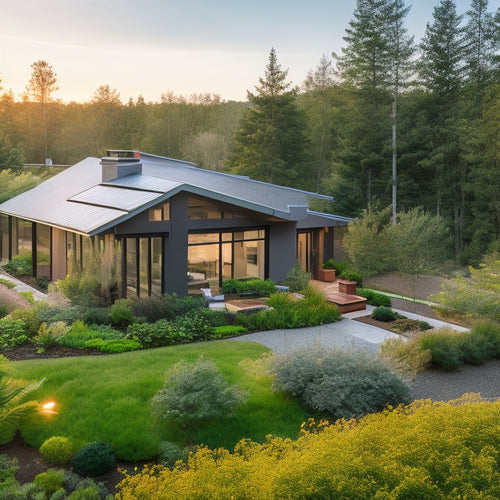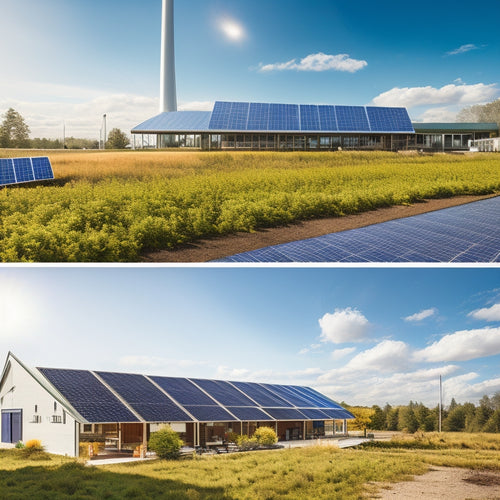
What Are the Key Components in the Cost of Household Solar Panels
Share
When investing in household solar panels, you need to evaluate six key cost components: system size and complexity, panel quality and efficiency, installation labor costs, mounting and racking systems, inverters and electrical components, and permits and inspection fees, all of which can greatly impact the overall expense of utilizing solar energy. These components interact in complex ways, and understanding their individual influences is vital for making informed decisions. By grasping these factors, you'll be better equipped to traverse the installation process and optimize your solar panel system's performance and cost-effectiveness - and there's more to investigate when it comes to getting the most out of your investment.
Key Takeaways
- System size and complexity, including energy usage, roof size, and local building codes, impact upfront costs and long-term energy savings.
- High-efficiency solar panels with premium quality and higher conversion efficiency rates increase energy output, but also boost upfront costs.
- Installation labor costs vary by location, complexity, and installer qualifications, making it essential to research local installers for better value.
- Mounting and racking systems, including fixed-tilt, adjustable-tilt, and tracking systems, affect costs and energy production, requiring a balance of performance and durability.
- Additional costs include inverters, electrical components, permits, and inspection fees, which vary by location and jurisdiction, emphasizing the need for accurate cost estimation.
System Size and Complexity
With the size of your solar panel system directly impacting its overall cost, it's vital to evaluate the complexity of the installation. A larger system will generally result in higher upfront costs, but it can also lead to greater energy savings in the long run.
You'll want to take into account factors like your energy usage, roof size, and local building codes to determine the ideal system size for your household.
A more complex installation can also drive up costs. For instance, if your roof has multiple angles or skylights, the installation process will be more intricate and require more labor hours.
On the other hand, a simpler installation can help reduce costs. By optimizing system performance, you can maximize energy savings and minimize your reliance on the grid.
It's important to work with a reputable installer who can assess your unique situation and design a system that meets your energy needs while keeping costs in check.
Panel Quality and Efficiency
Since you're investing in a solar panel system, you naturally want it to generate as much electricity as possible. The quality and efficiency of your solar panels play an essential role in achieving this goal. High-efficiency panels can produce more energy per hour of sunlight, resulting in higher energy output and reduced electricity costs.
Additionally, premium panels often come with a longer lifespan, typically ranging from 25 to 30 years or more, ensuring a longer period of energy generation.
When evaluating panel quality, look for modules with high conversion efficiency rates, usually above 20%. This indicates the panel's ability to convert sunlight into usable electricity.
You should also consider the panel's temperature coefficient, which affects its performance in hot climates. A lower temperature coefficient means the panel will maintain its energy output even in high temperatures.
While high-quality panels may come at a higher upfront cost, they can provide long-term savings through increased energy output and a longer panel lifespan.
Installation Labor Costs
Your solar panel system's installation labor expenses are a significant component of the overall cost, and they can vary widely depending on several factors.
The most important factor is the installation company's labor qualifications. You want a team with extensive experience and certifications, such as NABCEP certification, to guarantee a high-quality installation. This knowledge comes at a cost, and you can expect to pay more for a reputable installer.
Another factor affecting labor costs is the installation timeframes. A more complex installation, such as one requiring multiple roof penetrations or custom mounting systems, will take longer to complete and increase labor expenses. On the other hand, a simple installation with a standard mounting system can be completed quickly, reducing labor costs.
Additionally, labor expenses can vary depending on your location. Installers in urban areas may charge more than those in rural areas due to higher costs of living and doing business.
Be sure to research local installers and compare their labor costs to find the best value for your money. By understanding these factors, you can make an informed decision when selecting an installer for your solar panel system.
Mounting and Racking Systems
How do mounting and racking systems impact the overall cost of your household solar panels? These components are essential in securing your solar panels to your roof and ensuring their ideal performance.
The cost of mounting and racking systems can vary depending on the type and quality of materials used. You'll need to take into account the durability and corrosion resistance of the mounting materials, as well as their compatibility with your roof type and local building codes.
Racking designs also play a significant role in the overall cost. You can choose from fixed-tilt, adjustable-tilt, or tracking systems, each with its own set of benefits and drawbacks.
Fixed-tilt systems are the most cost-effective, while tracking systems can increase energy production but are more expensive. The complexity of the racking design and the number of components required will also impact the cost.
When selecting a mounting and racking system, you should balance cost with performance and durability. A high-quality system may cost more upfront but will provide better energy production and require less maintenance over time.
Be sure to research and compare different options to find the best fit for your household solar panel system.
Inverters and Electrical Components
When you're considering the cost of household solar panels, you'll need to factor in the inverters and electrical components that convert DC power into AC power for your home.
There are different types of inverters, including string inverters, microinverters, and power optimizers, each with its own set of benefits and drawbacks.
You'll also need to account for the cost of electrical wiring and other electrical components that connect the solar panels to the inverter and the grid.
Inverter Types
Inverters, an essential link between your solar panel array and the electrical grid, play an important role in converting DC power into usable AC electricity for your home. When selecting an inverter, you'll need to evaluate the type that best suits your needs. There are three main types: string inverters, microinverters, and power optimizers.
| Inverter Type | Description |
|---|---|
| String Inverters | Connect multiple solar panels in a single string, converting DC power to AC |
| Microinverters | Attached to each solar panel, converting DC power to AC at the panel level |
| Power Optimizers | Optimize energy output from each panel, then convert DC to AC at a central inverter |
Each type has its advantages and disadvantages. String inverters are often the most cost-effective, but can be affected by shading or panel mismatch. Microinverters provide more flexibility and panel-level monitoring, but are generally more expensive. Power optimizers offer a balance between the two, providing some flexibility and panel-level optimization. When choosing an inverter, evaluate factors like inverter efficiency, inverter lifespan, and your specific solar panel configuration to guarantee you get the most out of your solar energy system.
Electrical Wiring Costs
As you've selected the ideal inverter type for your solar panel array, it's now time to contemplate the electrical wiring costs associated with connecting your system to the grid.
These costs can vary depending on the type and quality of wiring materials used, as well as the installation methods employed. High-quality wiring materials, such as copper or aluminum, can be more expensive than lower-quality options, but they provide better conductivity and durability.
The installation method also plays a significant role in determining electrical wiring costs. A more complex installation, such as running wires through walls or under flooring, can increase labor costs. On the other hand, a simpler installation, like running wires along exterior walls, can reduce labor costs.
Additionally, the distance between your solar panel array and the electrical panel also affects wiring costs, as longer runs of wire are required.
Permits and Inspection Fees
When you're planning to install household solar panels, you'll need to factor in permits and inspection fees, which can vary depending on your location.
You'll need to pay local government fees for permits, which cover the cost of reviewing and approving your solar panel system design.
Additionally, you'll need to guarantee your system complies with building code requirements, which may require inspection and testing to verify its safety and performance.
Local Government Fees
Local government fees, comprising permits and inspection fees, are a necessary expense in the installation of household solar panels. These fees vary by jurisdiction and can add up quickly. As you consider installing solar panels, it's crucial to factor in these costs to guarantee a smooth and hassle-free installation process.
To minimize the financial burden, you may be eligible for local incentives, tax credits, or utility rebates that can offset some or all of these fees. Financing options and community programs can also help spread the cost over time. Be sure to research and take advantage of these opportunities to maximize your savings.
Some local government fees to expect include:
-
Building permit fees: These fees cover the cost of reviewing and approving your solar panel installation plans.
-
Inspection fees: These fees cover the cost of inspecting your installation to verify it meets local building codes and safety standards.
-
Zoning and land-use fees: These fees cover the cost of verifying that your solar panel installation complies with local zoning laws and land-use regulations.
Building Code Compliance
You'll need to secure the necessary permits and pass inspections to guarantee your solar panel installation meets local building codes and safety standards. Failing to comply with these regulations can lead to costly rework, fines, or even system shutdown.
As you maneuver through the permitting process, be prepared to address compliance challenges, such as outdated code updates that may not account for modern solar panel technology.
Your solar panel installer should be familiar with local building codes and regulations, ensuring a smooth permitting process. However, it's vital to verify their knowledge and experience with similar projects in your area.
You may need to provide documentation, such as system design plans, electrical diagrams, and manufacturer certifications, to support your permit application.
Permit and inspection fees vary by locality, but expect to pay anywhere from a few hundred to several thousand dollars, depending on the complexity of your installation and the jurisdiction's requirements.
Factor these costs into your overall budget to avoid surprises down the line. Remember, building code compliance is critical for ensuring your solar panel system operates safely and efficiently.
Inspection and Testing
Your solar panel system undergoes a series of inspections and tests to confirm it meets the required safety and performance standards. These inspections and tests are vital to guarantee your system operates efficiently and safely.
You'll need to factor in the cost of permits and inspection fees, which can vary depending on your location and local regulations.
When it comes to inspection and testing, you can expect the following:
-
System performance monitoring: Regular checks to verify your solar panel system is generating electricity at peak levels.
-
Solar panel maintenance: Scheduled maintenance to identify and address any potential issues before they become major problems.
-
Electrical safety inspections: Thorough inspections to confirm your system meets electrical safety standards and codes.
These inspections and tests not only verify your system is functioning correctly but also help identify potential issues early on, reducing the need for costly repairs down the line.
Frequently Asked Questions
How Long Does a Typical Solar Panel Installation Take?
You'll typically spend 2-5 days on a solar panel installation, divided into project phases: assessment, permitting, equipment delivery, and setup. The installation timeline varies depending on your roof size, complexity, and local regulations.
Can I Install Solar Panels on a Metal Roof?
As you chart your solar expedition, imagine your metal roof as a blank canvas, waiting for panels. Yes, you can install solar panels on a metal roof, leveraging its advantages like durability and water-tightness, but consider specialized installation considerations, like securing panels to the metal substrate.
Do Solar Panels Work During Power Outages?
You'll find that solar panels don't provide power during outages, as they're grid-tied for safety and efficiency. However, you can opt for a backup power system, like a battery storage system, to maintain solar panel efficiency and energy supply during outages.
Are There Any Solar Panel Recycling Options Available?
"An ounce of prevention is worth a pound of cure" - you're wise to contemplate solar panel disposal. Yes, you can opt for sustainable recycling options, which involve dismantling and recycling materials like silicon, aluminum, and glass, reducing waste and environmental impact.
Can I Install Solar Panels Myself to Save Money?
You're considering a DIY installation to save money, but it's essential to weigh the cost savings against potential risks, such as improper installation, safety hazards, and voided warranties, which could ultimately offset any initial cost benefits.
Conclusion
As you consider utilizing the power of the sun, it's essential to crunch the numbers. The cost of household solar panels is a complex calculation, but breaking it down to its core components can help. System size and complexity, panel quality and efficiency, installation labor costs, mounting and racking systems, inverters and electrical components, and permits and inspection fees all factor in. By grasping these key components, you'll gain a clearer understanding of the costs involved, allowing you to make an informed decision about going green with solar power.
Related Posts
-

Solar Power for Reducing Carbon Footprint
Solar power is an effective strategy for reducing your carbon footprint. By adopting solar energy, you can cut greenh...
-

Sustainable Home Design for Reduced Carbon Footprint
Sustainable home design is your pathway to a smaller carbon footprint and a healthier living space. By incorporating ...
-

Off-Grid Solar Solutions for Eco-Conscious Businesses
Off-grid solar solutions offer you a path to both sustainability and substantial cost savings. By adopting these syst...


